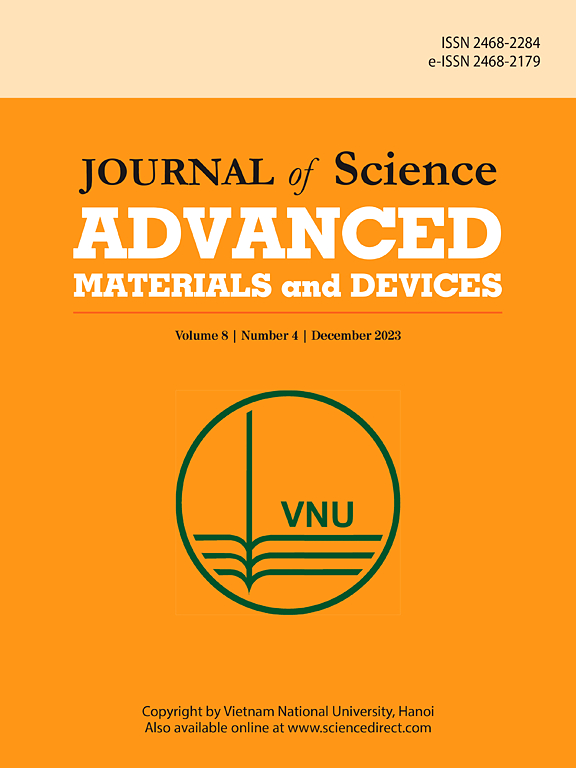Electrocatalytic carbon dioxide reduction microchanneled with nanostructured electrodes
IF 6.8
3区 材料科学
Q1 MATERIALS SCIENCE, MULTIDISCIPLINARY
Journal of Science: Advanced Materials and Devices
Pub Date : 2025-05-05
DOI:10.1016/j.jsamd.2025.100897
引用次数: 0
Abstract
The electrocatalytic reduction of carbon dioxide (CO2) is a promising solution for the utilization of renewable energy. Conversion to other useful substances is expected to diversify the applications of CO2 and alleviate the environmental problems caused by the continuous increase in its concentration in the atmosphere. Herein, an electrochemical reduction microdevice was developed to increase the reduction current density and explore the possibility of the highly efficient electrochemical reduction of CO2 to produce methane (CH4). A serpentine microchannel composed of an interdigitated Cu cathode and a Pt anode was filled with an electrolyte, and CO2 gas was flowed through it to attempt CO2 reduction. To increase the electrocatalytic reaction activity, the base of the electrodes was made of porous Si prepared through metal-assisted chemical etching. This configuration reduced the distance between the anode and cathode and increased the current density. The average Faraday efficiency reached 40 % at an applied potential of −4.2 V versus reversible hydrogen electrode (vs. RHE), with a current density of 316 mA/cm2 at a temperature of 20 °C. The unique configuration of the microdevice with the interdigitated porous electrodes ensured a high current density and showed a high CO2 reduction efficiency.
纳米结构电极微通道电催化二氧化碳还原
电催化还原二氧化碳(CO2)是一种很有前途的可再生能源利用解决方案。将二氧化碳转化为其他有用物质预计将使二氧化碳的应用多样化,并减轻其在大气中浓度不断增加所造成的环境问题。为了提高还原电流密度,探索高效电化学还原CO2生成甲烷(CH4)的可能性,开发了电化学还原微器件。在一个由交叉的铜阴极和铂阳极组成的蛇形微通道中填充电解液,并使CO2气体流过该微通道以尝试还原CO2。为了提高电催化反应的活性,电极的基底采用金属辅助化学蚀刻法制备多孔硅。这种结构减少了阳极和阴极之间的距离,增加了电流密度。与可逆氢电极(vs. RHE)相比,在−4.2 V的施加电位下,电流密度为316 mA/cm2,温度为20°C时,平均法拉第效率达到40%。该微器件独特的结构与交错的多孔电极保证了高电流密度和高CO2还原效率。
本文章由计算机程序翻译,如有差异,请以英文原文为准。
求助全文
约1分钟内获得全文
求助全文
来源期刊

Journal of Science: Advanced Materials and Devices
Materials Science-Electronic, Optical and Magnetic Materials
CiteScore
11.90
自引率
2.50%
发文量
88
审稿时长
47 days
期刊介绍:
In 1985, the Journal of Science was founded as a platform for publishing national and international research papers across various disciplines, including natural sciences, technology, social sciences, and humanities. Over the years, the journal has experienced remarkable growth in terms of quality, size, and scope. Today, it encompasses a diverse range of publications dedicated to academic research.
Considering the rapid expansion of materials science, we are pleased to introduce the Journal of Science: Advanced Materials and Devices. This new addition to our journal series offers researchers an exciting opportunity to publish their work on all aspects of materials science and technology within the esteemed Journal of Science.
With this development, we aim to revolutionize the way research in materials science is expressed and organized, further strengthening our commitment to promoting outstanding research across various scientific and technological fields.
 求助内容:
求助内容: 应助结果提醒方式:
应助结果提醒方式:


